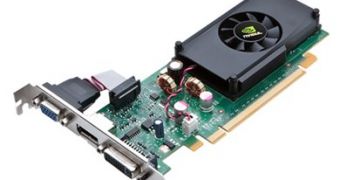NVIDIA's two 'new' graphics adapters seem to be the GPU manufacturer's way of addressing the issue of low-end users who would still like their old systems to have at least a minimum of graphics capabilities. Ironically, the GeForce 310 is not, as one would expect (and wish), any debut of a new adapter series, nor does it have any special capabilities, being instead little more than just a renamed GeForce 210 (or so it seems to be the case, so far at least).
The 310 is a PCI-Express 2.0 card, which supports OpenGL 3.0 and Microsoft DirectX 10.1, has a 64-bit memory interface, 16 CUDA cores and a memory bandwidth of 8Gbps. In addition, the frequencies are of 589MHz for the graphics clock, of 1402MHz for the processor clock and its 512 MB of standard memory run at a clock speed of 500MHz. The maximum digital and VGA resolutions attainable by this adapter are, like those of the GeForce 210, 2560 x 1600 and 2048 x 1536, respectively. The card's connectivity options include ports for DVI, VGA, DisplayPort and feature Via Dongle (DVI-HDMI or DP-HDMI) with an internal audio input. The adapter supports multi-monitor setups and has a maximum power consumption of 30.5W.
The specs are, as one could easily notice, quite similar between the 310 and the 210 and, so, the performance is probably identical as well, including the ability to fully accelerate 1080p video. The new model could theoretically boast certain performance improvements if additional features are implemented at the software level, such as software-based PhysX or CUDA support.
The GeForce 205 is the real 'new' adapter, although, really, it's actually even less capable than the 310/210. Compared with the latter, the GeForce 205 has only eight CUDA cores and the VGA connectivity is optional. Besides these two distinct features, the specifications are quite the same as those listed above. In truth, these capabilities are no better than the specs of 2003 mainstream adapters such as GeForce FX 5600/5700. It is noticeable that the 205 is actually slower than some integrated graphics processors, not just from ATI/AMD, but also those of Intel and NVIDIA itself. This means that these two products will likely be chosen by those who run systems that are several years old and have no support for the more recent technology.
The two 'new' graphics cards from NVIDIA are, obviously, aimed at the very low-end market segment. Currently, they are only available as part of prebuilt (OEM) systems. This might mean that NVIDIA is well aware of the fact that marketing these adapters as stand-alone products will more than probably result in a very poor marketing performance, considering the fact that Intel is set to release Core i3 and Core i5 chips with integrated graphics circuits, which will most likely be faster and more powerful.

 14 DAY TRIAL //
14 DAY TRIAL //